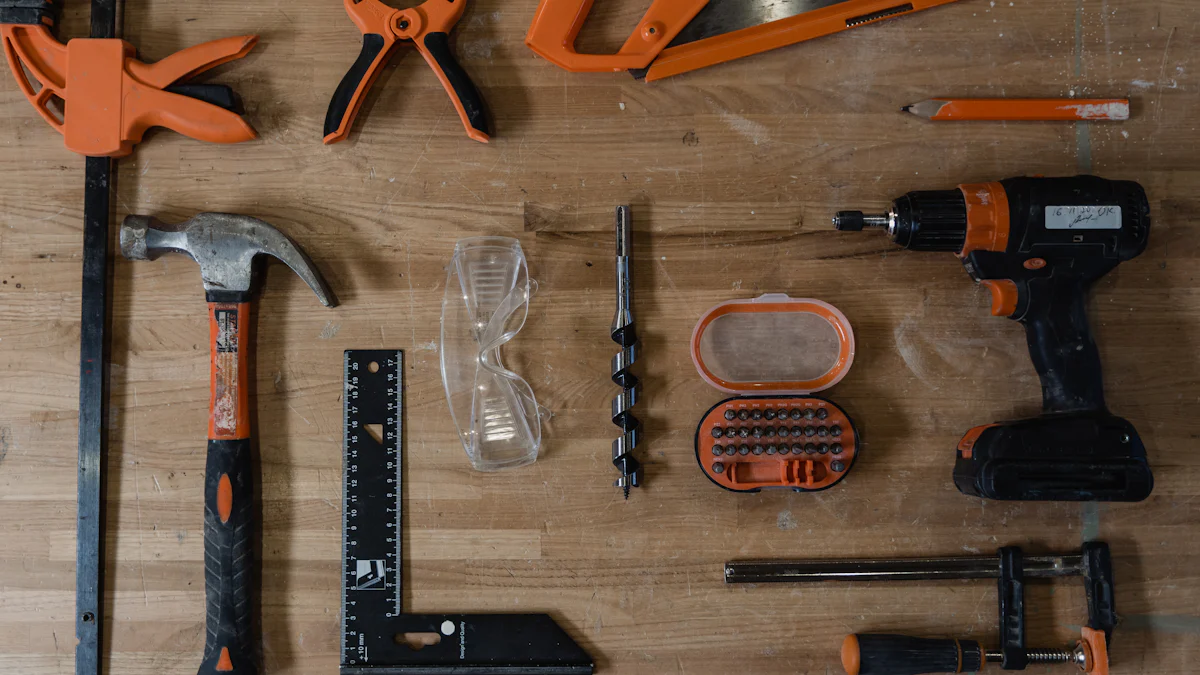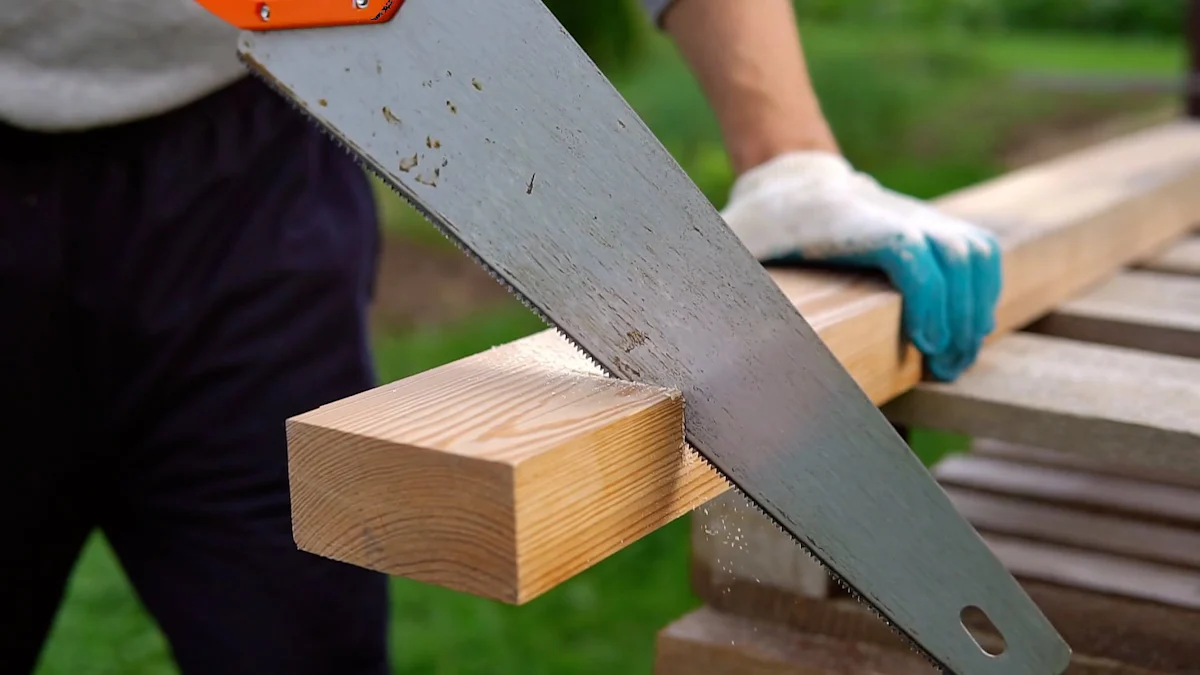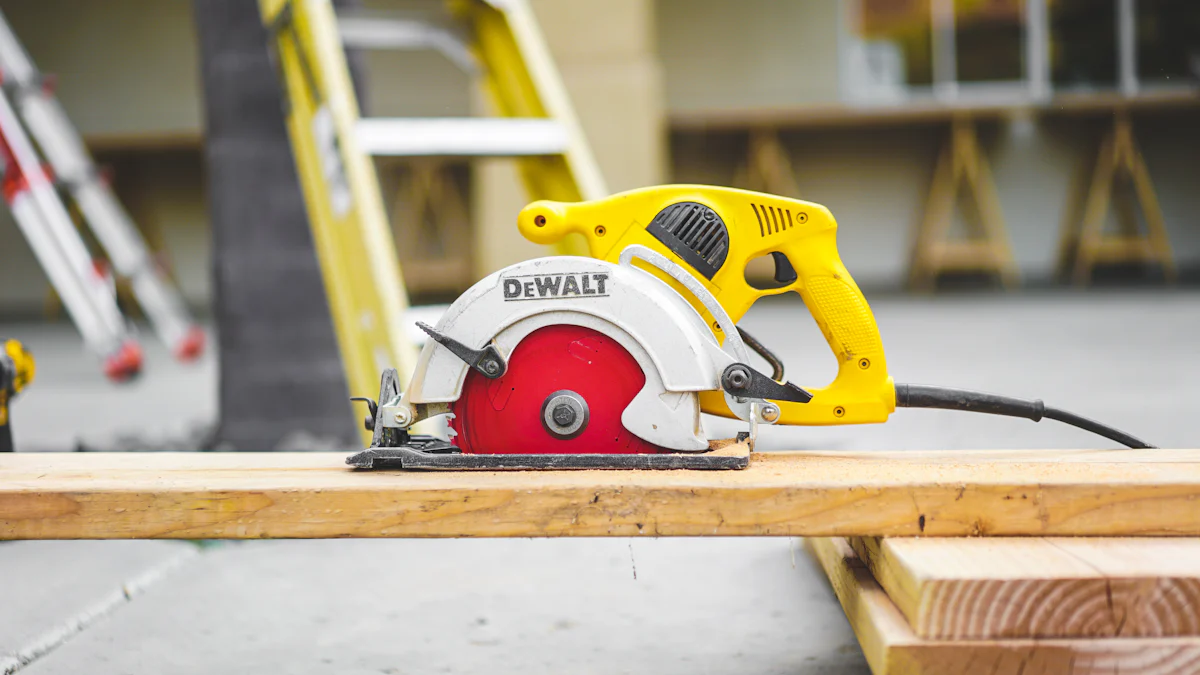
Woodworking requires the right tools to cut wood efficiently. Proper tools ensure precision and safety. Versatile tools can handle various projects, from simple cuts to intricate designs. Understanding each tool’s purpose enhances craftsmanship. The following sections will explore essential woodworking tools.
Hand Saws

Hand saws are essential tools to cut wood manually. They provide control and precision for various woodworking tasks.
Crosscut Saw
Features and Uses
A crosscut saw is designed to cut across the grain of the wood. The teeth on a crosscut saw are angled and sharpened to act like a series of knives. This design allows the saw to slice through wood fibers cleanly. The Rob Cosman’s Hand Saw Set includes a crosscut saw with 9 teeth per inch (TPI). This feature ensures smooth and precise cuts. The Picus Topman Coping Saw also serves well for deep crosscuts on conventional sawn wood, plywood, and laminated boards.
Maintenance Tips
Maintaining a crosscut saw involves regular sharpening and cleaning. Use a file to sharpen the teeth individually. Ensure each tooth has the same height for consistent cuts. Clean the blade after each use to prevent rust. Store the saw in a dry place to avoid moisture damage.
Rip Saw
Features and Uses
A rip saw is designed to cut along the grain of the wood. The teeth on a rip saw are chisel-shaped and set at a lower angle. This design allows the saw to split the wood fibers efficiently. The Rob Cosman’s Hand Saw Set includes a rip saw with 7 TPI. This feature provides a balance between speed and smoothness. The 11 Rip Crosscut Ryoba Saw offers a unique dual-edge design. One side features rip teeth, enhancing versatility.
Maintenance Tips
Maintaining a rip saw requires regular sharpening and cleaning. Use a file to sharpen the teeth, ensuring uniform height. Clean the blade after each use to remove sawdust and prevent rust. Store the saw in a dry environment to protect it from moisture.
Power Saws

Power saws provide efficiency and precision in woodworking projects. These tools to cut wood are essential for both beginners and experienced woodworkers.
Circular Saw
Features and Uses
A circular saw is a versatile tool used for making straight cuts in wood. The circular blade rotates at high speed, allowing for quick and clean cuts. This tool can handle various materials, including hardwood, softwood, and plywood. The DEWALT 7-1/4-Inch Circular Saw features a powerful motor and an adjustable bevel for angled cuts. The Makita 5007Mg Magnesium Circular Saw offers durability and lightweight construction, making it easy to maneuver.
Safety Tips
Safety is crucial when using a circular saw. Always wear safety goggles to protect your eyes from flying debris. Ensure the blade guard is in place before operating the saw. Keep hands away from the cutting area to avoid injuries. Use clamps to secure the wood, preventing movement during cutting. Disconnect the power source when changing the blade or performing maintenance.
Jigsaw
Features and Uses
A jigsaw is ideal for making curved and intricate cuts in wood. The narrow blade moves up and down, allowing for precise control. This tool can cut through various materials, including wood, metal, and plastic. The Bosch JS470E Jigsaw features a variable speed dial for adjusting the cutting speed. The BLACK+DECKER BDEJS600C Jigsaw offers a wire guard for improved line of sight and accuracy.
Safety Tips
Using a jigsaw requires attention to safety. Wear safety glasses to protect your eyes from dust and debris. Ensure the blade is properly installed and secured before use. Keep fingers away from the blade path to prevent accidents. Use a stable work surface to avoid vibrations that can affect control. Unplug the jigsaw when changing blades or performing maintenance.
Specialty Saws
Coping Saw
Features and Uses
A coping saw excels at making intricate cuts in wood. The Japanese Free-Way Spiral Coping Saw Blade stands out due to its spiral-tooth design. This feature allows cuts in any direction without turning the saw. The frame ensures proper tension on the blade, enhancing control. The TAIYO PICUS DS-178D Coping Saw includes two different 360-degree blades. One blade is spiral, and the other is diamond. Both blades provide versatility for various cutting needs. The maximum cutting depth reaches 130 mm, making it suitable for deep cuts.
Best Practices
Using a coping saw requires specific techniques for optimal results. Always secure the wood firmly before cutting. This prevents movement and ensures precision. Use smooth, steady strokes to avoid breaking the blade. Regularly check the blade tension to maintain consistent performance. Clean the saw after each use to remove sawdust and debris. Store the coping saw in a dry place to prevent rust.
Japanese Saw
Features and Uses
A Japanese saw, known for its pull-stroke cutting action, provides clean and precise cuts. The Rob Cosman’s Hand Saw Set includes a Japanese saw designed for both crosscut and rip cut. The saw features a thick, durable SK85 spring steel blade. This material ensures longevity and edge retention. The teeth, cut using a CNC diamond saw, offer high consistency and sharpness. The minimal set per side keeps the saw straight during cuts, enhancing accuracy.
Best Practices
To achieve the best results with a Japanese saw, follow these practices. Hold the saw with a firm grip and use controlled, even strokes. Avoid applying excessive force, as the pull-stroke design requires less effort. Regularly sharpen the teeth to maintain cutting efficiency. Clean the blade after each use to prevent buildup of resin and sawdust. Store the saw in a protective case to avoid damage.
Cutting Tools for Precision
Precision tools to cut wood are essential for achieving fine details and smooth finishes in woodworking projects. Chisels and planes are indispensable for these tasks.
Chisels
Chisels are versatile tools to cut wood, ideal for carving, shaping, and detailing. Different types of chisels serve various purposes, enhancing the woodworker’s ability to create intricate designs.
Types of Chisels
- Bench Chisels: These are general-purpose chisels used for a wide range of tasks. They come in various sizes and are perfect for paring and chopping.
- Mortise Chisels: Designed for cutting mortises, these chisels have thick blades to withstand heavy mallet blows.
- Paring Chisels: These chisels have long, thin blades for delicate work. They are ideal for shaving off thin slices of wood.
- Japanese Chisels: Known for their sharpness and durability, these chisels are excellent for fine woodworking.
Sharpening Tips
Sharpening chisels regularly ensures optimal performance. Follow these steps for effective sharpening:
- Use a Whetstone: Start with a coarse grit and progress to finer grits. This method ensures a sharp edge.
- Maintain the Angle: Keep the chisel at a consistent angle, usually around 25 to 30 degrees.
- Hone the Edge: Use a honing guide to maintain the correct angle and achieve a razor-sharp edge.
- Strop the Blade: Finish by stropping the blade on leather to remove any burrs and polish the edge.
Planes
Planes are essential tools to cut wood, used for smoothing surfaces and achieving precise thickness. Different types of planes cater to various woodworking needs.
Types of Planes
- Bench Planes: These planes come in various sizes and are used for flattening and smoothing large surfaces.
- Block Planes: Smaller than bench planes, block planes are ideal for trimming and fitting joints.
- Shoulder Planes: These planes are designed for trimming tenons and shoulders, providing clean and accurate cuts.
- Chisel Planes: Unique in design, chisel planes function like a paring chisel with depth control. The Woodriver Chisel Plane excels in tight spaces and precise tasks.
Usage Tips
Using planes effectively requires proper technique and maintenance:
- Adjust the Blade: Set the blade depth according to the task. A shallow setting is ideal for fine shavings, while a deeper setting removes more material.
- Maintain Sharpness: Regularly sharpen the blade to ensure clean cuts. A dull blade can tear the wood fibers.
- Use Consistent Pressure: Apply even pressure throughout the stroke to achieve a smooth finish.
- Clean the Plane: After each use, clean the plane to remove sawdust and resin. This practice prevents rust and maintains performance.
Supporting Tools
Clamps
Clamps are essential for holding wood pieces securely during cutting, gluing, or assembling. Different types of clamps serve various purposes in woodworking projects.
Types of Clamps
- Bar Clamps: Bar clamps have a long metal bar and adjustable jaw. They are ideal for large projects requiring significant clamping force.
- C-Clamps: C-clamps feature a screw mechanism for tightening. These clamps are versatile and suitable for smaller tasks.
- Pipe Clamps: Pipe clamps use a pipe to provide adjustable length. They offer strong clamping pressure for larger projects.
- Spring Clamps: Spring clamps use a spring mechanism for quick and easy clamping. These clamps are perfect for light-duty tasks.
- Corner Clamps: Corner clamps hold pieces at a right angle. They are useful for assembling frames and boxes.
Usage Tips
Using clamps effectively enhances the quality of woodworking projects:
- Select the Right Clamp: Choose a clamp that matches the size and requirements of the project.
- Apply Even Pressure: Tighten the clamp evenly to avoid damaging the wood.
- Use Protective Pads: Place pads between the clamp jaws and wood to prevent marks and dents.
- Check Alignment: Ensure the wood pieces remain aligned while clamping.
- Regular Maintenance: Clean and lubricate clamps regularly to maintain smooth operation.
Measuring Tools
Accurate measurements are crucial for precise cuts and fits in woodworking. Various measuring tools help achieve this accuracy.
Essential Measuring Tools
- Tape Measure: A tape measure provides flexible and portable measurement. It is essential for measuring lengths and widths.
- Combination Square: A combination square offers 90-degree and 45-degree angles. It is useful for marking and checking angles.
- Calipers: Calipers measure internal and external dimensions with high precision. They are ideal for detailed work.
- Marking Gauge: A marking gauge scores lines parallel to an edge. It ensures consistent measurements.
- Digital Measuring Tools: Digital tools offer enhanced accuracy and ease of use. They display measurements on a digital screen.
Accuracy Tips
Maintaining accuracy in measurements ensures the success of woodworking projects:
- Calibrate Tools Regularly: Check and calibrate measuring tools to ensure accuracy.
- Measure Twice, Cut Once: Double-check measurements before making cuts to avoid mistakes.
- Use a Stable Surface: Measure on a flat and stable surface to prevent errors.
- Mark Clearly: Use sharp pencils or marking knives for clear and precise lines.
- Avoid Parallax Errors: View the measurement scale directly to avoid reading errors.
Supporting tools like clamps and measuring tools play a vital role in woodworking. Proper use and maintenance of these tools contribute to the overall quality and precision of projects.
Recap the essential tools discussed in the blog. Emphasize the importance of using the right tool for each job. Encourage investing in quality tools for better results. Quality tools enhance craftsmanship and safety. Woodworking provides a fulfilling and rewarding experience.
“Woodworking is not only good, but great for me. It allows me to utilize everything I’ve been gifted with.” — Nicholas S.
Invite readers to share favorite tools or tips in the comments. Engaging with the community fosters learning and improvement.
See Also
Complete Winter Handbook for Cozy Feet with Fuzzy Socks
Discovering Diverse Sock Options for Both Genders
Cruising Gear: Best Quality Components for Scooters
